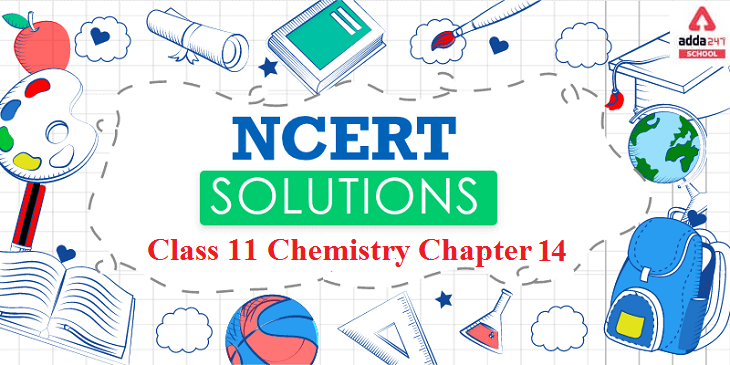Ncert Solutions For Class 11 Chemistry Chapter 14 Pdf Download
Adda247 provides NCERT Solutions for class 11 Chemistry. The NCERT Solutions provided here will enhance the concepts of the students, as well as suggest alternative methods to solve particular problems to the teachers.
Chemistry is much more than the language of Science. We aim to aid the students with answering the questions correctly using logical approach and methodology. The NCERT Solutions provide ample material to enable students to form a good base with the fundamentals of the subject.
Students who are looking for Class 11 Chemistry NCERT Solutions can refer to this article. Students will be provided detailed Class 11 Chemistry NCERT Solutions. Students can find here NCERT Solutions of Class 11 Chemistry PDF in Hindi and English medium.
Students of Class 11 must be through with Science NCERT Class 11 Chemistry Solutions in order to secure good marks in the board exams. These solutions will not only help the students to prepare for board exams but also prepare for competitive medical and engineering entrance exams.
Chemistry is an interesting subject but many of your students might find it confusing to understand. It can be a struggle for many of you.
From the NCERT Solutions at Adda247, students will clearly learn about all the chemical reactions which occur in our day to day life. The solutions explain each and every minute concept in a best way possible so that students do not face any problem in the exam. It not only boost their exam preparation but also provides a strong foundation of fundamental concepts which frequently appear in various competitive exams. Using these solutions, students will understand how to approach complex questions that would arise in the exam and answer them with full confidence.
Benefits of Solutions of NCERT class 11 Chemistry:
- NCERT Solutions for Class 11 is helpful to solve questions from other reference books too.
- NCERT Solutions for class 11 Chemistry will assist students to cross check answers and prepare for the exams in a strategic way.
The students can access the solutions anywhere while browsing web easily. The solutions are very precise and accurate.
NCERT Solutions of Chemistry Class 11 Chapter 14: Environmental Chemistry
Hydrogen is the most abundant in this universe, and thus any knowledge about this element allows one to explore numerous scientific phenomenon. Keeping this aspect in mind, CBSE has incorporated this topic into their curriculum so that keen students can learn the basic of this element.
Such a topic may seem challenging for students to decipher. In such a synopsis, they can rely on Hydrogen Class 11 Chemistry NCERT Solutions that provide comprehensive guidance on this topic with its eloquent explanation.
[sso_enhancement_lead_form_manual title=”Download Full PDF of Class 11 Chemistry Chapter 14 ” button =”Download Now” pdf =”/jobs/wp-content/uploads/2021/07/13021010/chapter-14-11th-class.pdf”]
Environmental Chemistry is an integral part of Class 11 syllabus and rightly so as it studies the ways to curb the harmful effect of Chemicals on the environment. This area of chemistry detects and modifies the sources of hazardous chemicals and focuses on limiting contaminations.
Environmental Chemistry Class 11 NCERT Solutions thus allow students to explore this side of chemistry. It also makes them aware of the potential chemical threats to the environment and encourages them to look for eco-friendly alternatives.
Paul Anastas, Ph. D. is known widely as the “Father of Green Chemistry” for his ground breaking research on the design, manufacture, and use of minimally-toxic, environmentally-friendly chemicals.
The practice of green chemistry must be based upon environmental chemistry. This important branch of chemical science is defined as the study of the sources, reactions, transport, effects, and fates of chemical species in water, soil, air, and living environments and the effects of technology thereon.
Environmental chemistry helps to develop methods and procedures to reduce the contaminants or the chemicals in the air, which improves the quality of air. Cleaner air with fewer chemicals leads to less damage to the lungs.
Environmental chemistry focuses on the presence and impact of chemicals in soil, surface water, and groundwater. Environmental chemists study how chemicals – usually contaminants – move through the environment. … They also study the effects of these contaminants on ecosystems, animals, and human health.
Environmental chemistry is an interdisciplinary science that includes atmospheric, aquatic and soil chemistry, as well as heavily relying on analytical chemistry and being related to environmental and other areas of science.
Environmental chemistry also deals with synthetic chemicals that have been manufactured by humans and dispersed into the environment, such as pesticides, polychlorinated biphenyls (PCBs), dioxins, furans, and many others.
Environmental chemistry focuses on the chemical processes influencing the composition and chemical speciation of natural systems (air, water and soils), the chemical fate and mobility of contaminants in the environment, chemical processes that affect the toxicity and bioavailability of contaminants, and chemical.
Environmental Science is an unusual academic discipline in that it requires scientific knowledge about the natural world, as well as an understanding about ways in which humans interact with the natural world. … Core courses in the Environmental Science major include biology, chemistry, geology, and mathematics.
Learn Environmental Chemistry
It focuses particularly on the influence of human activities on chemicals in our world. Learn essential chemistry concepts. Study the environment – air, water, soil – and understand the elements of pollution, their sources, and how pollution can be controlled.
Due to being somewhat of a cross-over field between physical and life sciences, Environmental Chemists can also be great educators. Your degree level helps determine your teaching eligibility. In order to teach at the college or university level, a PhD is either required or recommended.
Key features of NCERT Solution for class 12 Chemistry Chapter 5: Surface Chemistry
- The NCERT Solution provide clear and precise answer.
- The columns are used wherever necessary.
- We follow the NCERT guidelines.
- Illustration through diagrams.
- Adequate examples for better explanation
Important questions of NCERT Solutions of Chemistry Class 11 Chapter 14
Question :1 What are the harmful effects of photochemical smog and how can they be controlled?
Answer :
Harmful effects of photochemical smog:
- Their high concentration causes headache, chest pain and dryness of the throat.
- Ozone and PAN act as powerful eye irritants.
- Photochemical smog leads to cracking or rubber and extensive damage to plant life.
- It causes corrosion of metals, stones, building materials and painted surface etc.
Control:
- Use of catalytic converter in automobiles prevent the release of nitrogen dioxide and hydrocarbons to the atmosphere.
- Pinus, Juniparus, Quercus, Pyrus like plants can metabolise nitrogen dioxide thus their plantation could help to some extent.
Question :2 What are the reactions involved for ozone layer depletion in the stratosphere?
Answer:
The reaction can be shown as follows :
CF2Cl2 + UV à Cl(g) + CF2Cl(g)
Cl(g) + O3(g) -> ClO(g) + O2(g)
ClO(g) + O(g) -> Cl + O2(g)
Question :3 What do you mean by ozone hole? What are it’s consequences?
Answer:
In polar regions, stratospheric clouds provide the surface for chlorine nitrate and hypochlorous acid. They react to form chlorine molecules. Photolysis of chlorine molecules and HOCl gives chlorine free radicals.
The chlorine free radicals lead to the decomposition of ozone
This initiates a chain reaction. The chlorine free radical is continuously regenerated which depletes the ozone layer. It is called ozone hole.
Consequences of ozone depletion:
The ozone layer protects the earth from the harmful UV radiations of the sun. Due to its depletion, more radiation enters the earth’s atmosphere. UV radiations cause aging of skin, cataract, skin cancer and sunburns. Hence, they are harmful. They cause the death of phytoplanktons which leads to a decrease of fish productivity. Excess exposure may even cause mutation in plants, increase UV radiation, decrease moisture content of soil and damage both plants and fibers.
Question :4 What are the major causes of water pollution? Explain.
Answer:
The major cause of water pollutions are –
- Radioactive waste- These waste substances are direct throw into the oceans.
- Pathogens- include bacteria and other organisms, which enters into the water from animal excreta and domestic sewage. Also, human excreta contain bacterias like Escherichia coli and Streptococcus faecalis which cause gastrointestinal diseases
- Organic Wastes- These are biodegradable waste that pollutes water as a consequence of runoff. The excess of organic matter in water causes a decrease in the amount of oxygen held by the water.
- Chemical pollutants- water-soluble inorganic chemicals such as heavy metals like cadmium, mercury, nickel etc. The presence of these metals in the human body, damages the kidneys, central nervous system, liver etc. These are dangerous for human beings because our body cannot excrete them.
Question :5 Have you ever observed any water pollution in your area? What measures would you suggest to control it?
Answer:
Yes, I observed water pollution in my area. As i Know, the contamination of water by foreign substance, which make of harmful for health of animals or plants or aquatic life and make it unfit for the domestic, industrial and agricultural use. It can be controlled by the following methods:
- i) Excessive amount of chemical fertilizers should be prevented.
- ii) Regularly, we should check pH of water. If pH value is maintained at 7 then, water is pure, otherwise polluted.
iii) Industrial waste discharge from fertilizers , paper , pesticides , detergents , drugs , industries and refineries should not be allowed to get mixed in water bodies like river, lakes etc.
- iv) Avoid the use of DDT, malathion at home.
- v) Domestic waste should be properly discharged and treated.
Question :6 Define environmental chemistry?
Answer:
Environmental chemistry is the branch of science which deals with the chemical phenomenon occurring in the environment. It includes our surroundings such as air, water soil, forest etc.
Question :7 Explain the tropospheric pollution in 100 words?
Answer :
Tropospheric pollution occurs due to the presence of undesirable substance in air. These may be the solid or gaseous pollutants.
- Gaseous air pollutants : These are oxides of sulphur, nitrogen and carbon, hydrogen sulphide hydrocarbons, ozone and other oxidants.
- Particulate pollutants : These are dust, mist fumes and smog etc.
Question :8 Carbon monoxide gas is more dangerous than carbon dioxide gas. Why? Answer :
Carbon monoxide combines with haemoglobin to form a very stable compound known as carboxyhaemoglobin when it’s concentration in blood reaches 3-4% ,the oxygen carrying capacity of the blood is greatly reduced because level of haemoglobin reduced and not available for combination with oxygen. This results into headache, nervousness and sometimes death of the person. On the other hand CO does not combine with haemoglobin and hence is less harmful than CO.
Question :9 List gases which are responsible for greenhouse effect.
Answer:
CO is mainly responsible for greenhouse effect. Other greenhouse gases are methane, nitrous oxide, water vapours, CFCs and ozone.
Question :10 Statues and monuments in India are affected by acid rain. How?
Answer:
This is mainly due to the large number of industries and power plants in the nearby areas. Acid rain has vapours of sulphuric acid dissolved in it. When it comes in contact with various statues or monuments, the acid reacts chemically with calcium carbonate.
CaCO3. + H2SO4 à CaSO4. + H2O + CO2
Question :11 What is smog? How is classical smog different from photochemical smog?
Answer :
The word smog is a combination of smoke and fog. It is a type of air pollution that occurs in many cities throughout world. Classical smog occurs in cool humid climate. It is also called as reducing smog form by combination of smoke, dust and fog containing sulphur oxides. Whereas photochemical smog occurs in warm and dry sunny climate. It has high concentration of oxidizing agents and therefore, it is also called as oxidising smog.
FAQs on NCERT Solutions of Chemistry Class 11 Chapter 14
- Why should you opt for Environmental Chemistry Class 11 NCERT Solutions?
Ans. Over the years, students have trusted NCERT Solutions for Class 11 Chemistry Chapter 14 Environmental Chemistry due to following reasons:
- Chemistry solutions are written in simple language and clean format for students to understand quickly.
- Essential equations are highlighted in separate space so that students can find them quickly and remember vividly.
- Teachers from all over the country contributed to design the book. Hence, the information about the solutions is accurate and advanced.
- Since this solution is aimed at class 11 final examinations, students and still can score decent marks.
- The questions encompass all difficulty levels starting from easy to hard.
- Name the topics/subtopics included in this chapter ‘Environmental Chemistry’.
Ans. The topics/subtopics included in this chapter ‘Environmental Chemistry’ are –
- Environmental Pollution
- Atmospheric Pollution
- Tropospheric Pollution
- Stratospheric Pollutions
- Water Pollution
- Causes of Water Pollution
- International Standards for Drinking Water
- Soil Pollution
- Pesticides
- Industrial Waste
- Strategies to Control Environmental Pollution
- Waste Management
- Green Chemistry
- Introduction
- Green Chemistry in day-to-day Life.
- What is the meaning of environmental Pollution according to NCERT Solutions for Class 11 Chemistry Chapter 14?
Ans. According to NCERT Solutions for Class 11 Chemistry Chapter 14, when there is an undesirable change in the surrounding that has harmful effects on plants and animals, it leads to environmental pollution. A pollutant is a substance that causes pollution. We can have pollutants in liquid, solid or gaseous form. A substance becomes a pollutant when its concentration is greater that the natural abundance and this increase in concentration is either due to human activities or natural phenomenon.
- How are the NCERT Solutions for Class 11 Chemistry Chapter 14 Helpful from an exam perspective?
Ans. NCERT Solutions for Class 11 Chemistry Chapter 14 is the most popular to refer for the board exams. Practising these solutions help the students to top the final exams and ace a subject. These solutions are devised, based on the most updated NCERT Solution for Class 11 Chemistry syllabus, covering all the crucial topics of respective subject.
- Define environmental chemistry.
Ans. Environmental chemistry involves the study of chemicals and chemical processes within the air, water, and soil. It also involves studying how these chemicals get there, what they do, and how humans are intertwined in all of this.
Environmental chemistry is more than just water, air, soil, and chemicals. People in this field use math, biology, genetics, hydrology, engineering, toxicology, and a lot more to help answer important questions about our environment, the chemicals therein, and what role people play in all of this or how it impacts us as a result.









 HBSE 12th Admit Card 2026 Date, Download...
HBSE 12th Admit Card 2026 Date, Download...
 XAT Result 2026 OUT, Check how to downlo...
XAT Result 2026 OUT, Check how to downlo...
 TS SBTET Result 2025 OUT @sbtet.telangan...
TS SBTET Result 2025 OUT @sbtet.telangan...














